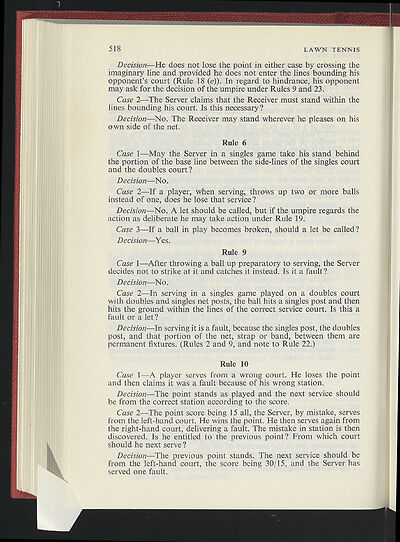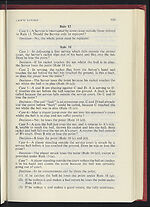1964-65
(544)
Download files
Complete book:
Individual page:
Thumbnail gallery: Grid view | List view

518
LAWN TENNIS
Decision
—He
does not lose the point in either case by crossing the
imaginary line and provided he does not enter the lines bounding his
opponent's court (Rule
18
(e)). In
regard to hindrance, his opponent
may ask for the decision of the umpire under Rules 9 and 23.
Case 2
—The Server claims that the Receiver must stand within the
lines bounding his court. Is this necessary?
Decision
—No.
The Receiver may stand wherever he pleases on his
own side of the net.
Rule 6
Case 1
—May the Server in a singles game take his stand behind
the portion of the base line between the side-lines of the singles court
and the doubles court?
Decision
—No.
Case
2—If a player, when serving, throws up two or more balls
instead of one, does he lose that service?
Decision—No.
A let should be called, but if the umpire regards the
action as deliberate he may take action under Rule 19.
Case
3—If a ball in play becomes broken, should a let be called?
Decision
—Yes.
Rule 9
Case 1
—After throwing a ball up preparatory to serving, the Server
decides not to strike at it and catches it instead. Is it a fault?
Decision
—No.
Case
2—In serving in a singles game played on a doubles court
with doubles and singles net posts, the ball hits a singles post and then
hits the ground within the lines of the correct service court. Is this a
fault or a let?
Decision
—In
serving it is a fault, because the singles post, the doubles
post, and that portion of the net, strap or band, between them are
permanent fixtures. (Rules 2 and 9, and note to Rule 22.)
Rule 10
Case 1
—A player serves from a wrong court. He loses the point
and then claims it was a fault because of his wrong station.
Decision
—The
point stands as played and the next service should
be from the correct station according to the score.
Case
2—The point score being 15 all, the Server, by mistake, serves
from the left-hand court. He wins the point. He then serves again from
the right-hand court, delivering a fault. The mistake in station is then
discovered. Is he entitled to the previous point? From which court
should he next serve?
Decision
—The
previous point stands. The next service should be
from the left-hand court, the score being 30/15, and the Server has
served one fault.
LAWN TENNIS
Decision
—He
does not lose the point in either case by crossing the
imaginary line and provided he does not enter the lines bounding his
opponent's court (Rule
18
(e)). In
regard to hindrance, his opponent
may ask for the decision of the umpire under Rules 9 and 23.
Case 2
—The Server claims that the Receiver must stand within the
lines bounding his court. Is this necessary?
Decision
—No.
The Receiver may stand wherever he pleases on his
own side of the net.
Rule 6
Case 1
—May the Server in a singles game take his stand behind
the portion of the base line between the side-lines of the singles court
and the doubles court?
Decision
—No.
Case
2—If a player, when serving, throws up two or more balls
instead of one, does he lose that service?
Decision—No.
A let should be called, but if the umpire regards the
action as deliberate he may take action under Rule 19.
Case
3—If a ball in play becomes broken, should a let be called?
Decision
—Yes.
Rule 9
Case 1
—After throwing a ball up preparatory to serving, the Server
decides not to strike at it and catches it instead. Is it a fault?
Decision
—No.
Case
2—In serving in a singles game played on a doubles court
with doubles and singles net posts, the ball hits a singles post and then
hits the ground within the lines of the correct service court. Is this a
fault or a let?
Decision
—In
serving it is a fault, because the singles post, the doubles
post, and that portion of the net, strap or band, between them are
permanent fixtures. (Rules 2 and 9, and note to Rule 22.)
Rule 10
Case 1
—A player serves from a wrong court. He loses the point
and then claims it was a fault because of his wrong station.
Decision
—The
point stands as played and the next service should
be from the correct station according to the score.
Case
2—The point score being 15 all, the Server, by mistake, serves
from the left-hand court. He wins the point. He then serves again from
the right-hand court, delivering a fault. The mistake in station is then
discovered. Is he entitled to the previous point? From which court
should he next serve?
Decision
—The
previous point stands. The next service should be
from the left-hand court, the score being 30/15, and the Server has
served one fault.
Set display mode to:
![]() Universal Viewer |
Universal Viewer | ![]() Mirador |
Large image | Transcription
Mirador |
Large image | Transcription
| Games and sports in the army > 1964-65 > (544) |
|---|
| Permanent URL | https://digital.nls.uk/249217320 |
|---|
| Description | 'Games and Sports in the Army' was an annual publication produced by the British War Office between the 1930s and 1960s. This included the Second World War. It outlines the rules and regulations for games and sports played by members of the armed forces. It features names and photographs of team members, and examples of contemporary advertising. |
|---|---|
| Shelfmark | GWB.52 |

